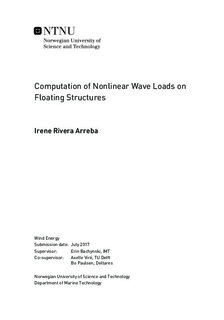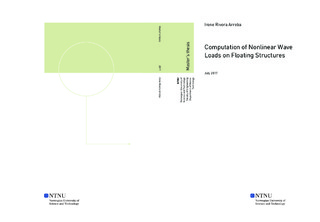| dc.description.abstract | Floating wind turbines (FWTs) are proposed as a method to harness the significant wind energy resource in deep water. International research efforts have led to the development of coupled numerical global analysis tools for FWTs in order to understand their behavior under wind and wave actions. The hydrodynamic models in such tools are typically based on first-(and second-)order potential flow theory, sometimes also including Morison s equation. In order to accurately model highly nonlinear waves, their interaction with a floating platform, and obtain estimates of the resulting loads on the structure, a numerical wave tank approach is generally needed.
In this thesis, the response of floating structures to nonlinear wave loading is investigated by means of two different numerical approaches: a fully nonlinear Navier-Stokes/VOF solver and a second-order potential flow theory solver. Firstly, the fully nonlinear Navier-Stokes/VOF numerical wave tank, developed within the open-source CFD toolbox OpenFOAMframework (version 1606+), is validated against experimental data for two cases. These comprise the response of a 2D floating box and a 3D floating vertical cylinder. In order to model the motions of the floating structures, together with the generation and absorption of the waves, the interDyMFoam solver, provided by the OpenFOAMlibrary, is extended with the waves2Foam package, developed by Jacobsen at al. (2012). Furthermore, a simple catenary mooring line is implemented for the moored cases. Secondly, a potential flow theory based model of the OC5-semisubmersible floating platform is generated. The frequency-domain analysis is done with the Wadam software and the time-domain simulations with SIMO. This model is validated against measurement data from a 1:50 scale test campaign performed at the MARIN offshore wave basin and the fully nonlinear validated CFD model. Lastly, both numerical models of the OC5-semisubmersible are compared in order to assess the suitability of the diffraction model in two different conditions where nonlinearities are of relevance. The first one involves very long waves, with periods close to 20s, which are likely to take place under swell wave conditions. These may excite the OC5-semisubmersible platform in heave at its natural frequency. The second situation deals with regular waves with increasing steepness.
In principle, the fully nonlinear CFD model, if no experimental data is available, is needed to calibrate the diffraction model. However, once the latter is adjusted and validated, results are given at a much lower computational cost. According to the computations throughout this work, when dealing with waves with high steepness and high excitation frequencies, the motions, as well as the peak forces, are properly captured by the diffraction model. However, other local effects of importance for offshore structures, such as wave run-up, or the different components in frequency of the loading, require the use of a fully nonlinear CFD solver. Therefore for preliminary design stages a diffraction model is able to give suitable results regarding the motions and peak inline and vertical forces at a much lower computational cost; however, for detailed design, or optimisation phase stages, where local effects are of relevance, a fully nonlinear CFD model is required. | |

